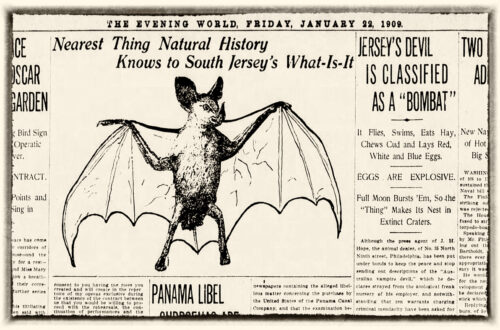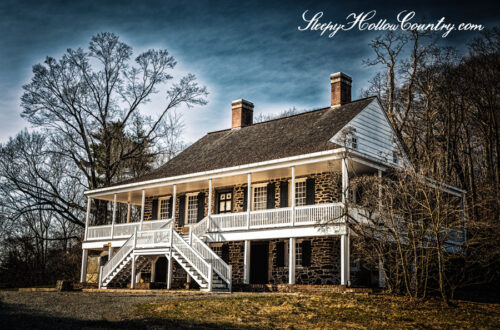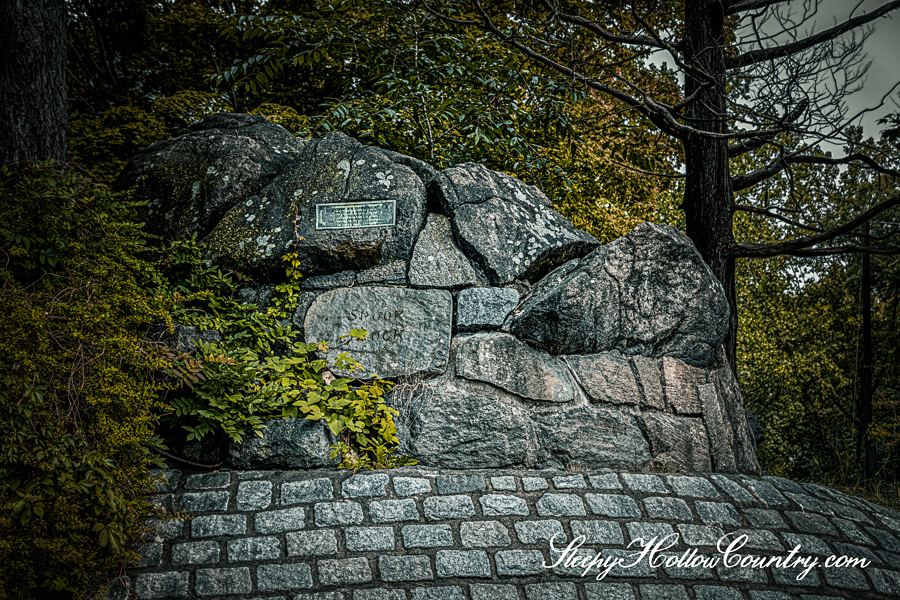
The Ramapo Spook Rock & Indian Rock
Rockland County is so aptly named for its enormous relationship with the geological. From the cliffs of the Palisades to the South, to the Ramapo Mountains in the west, “…the county appears to have been well named, and it is not surprising that it was not looked on in favor as an agricultural region” as there are just a lot of rocks. But not just any old run-of-the-mill stones, there are two of particular interest in this region, protruding into modern-day from the past to remind us of the many things that were here before and that sometimes history and lore are forever entwined.
Spook Rock
The terminology of “spook rock” seems to refer to a particular type of stone formation that is associated with ghosts and tragedy in association with the local indigenous tribes of a region. There are spook rocks aplenty in Sleepy Hollow Country and beyond, but in a land so aptly named for its main defining feature it would have been even weirder perhaps if there wasn’t one.
Towering over a busy modern intersection (Spook Rock Road & Highview Road) in the western reaches of the county sits Spook Rock. It appears to have once been a large boulder outcropping, with splits and crags that have since cleaved further. Hand-hewn stones, with smooth sides support this small peak with the words ‘Spook Rock’ emblazoned across them, in two places. Below those older additions, a more contemporary curved buttress further protects this well-fortified stone. It has the well-protected appearance of a battlement.
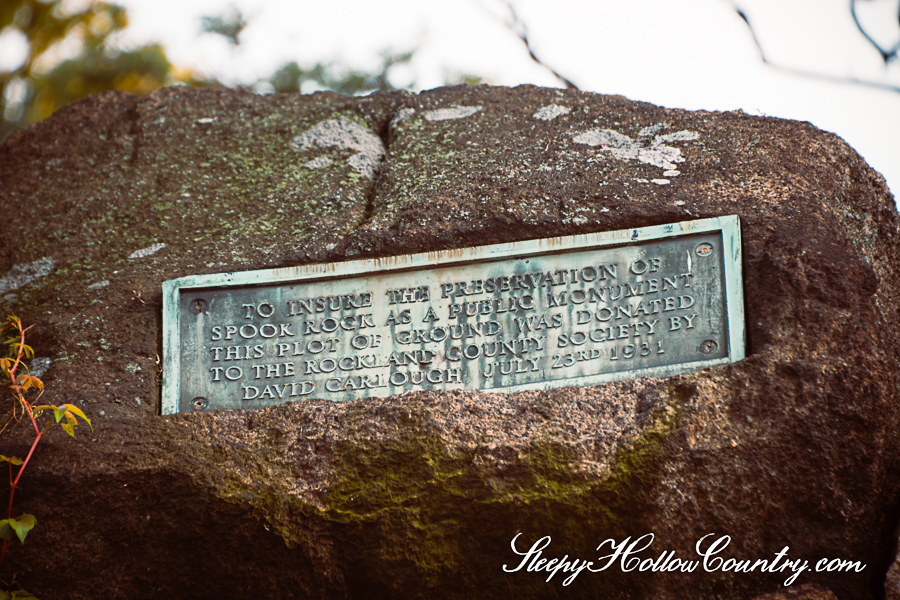
Appearances aside, the story of this Spook Rock is a simple one. According to a 1931 The Rockland County Times, the rock was a sacred and ancestral meeting place for many of the indigenous people in the region, convening here for many occasions until they finally abandoned the region.
“After the passing of the indian, the white settlers regarded the Rock as still under the dominion of the native god, and stories were soon afloat of the uncanny sounds heard and weird things seen near the spot, and the Dutch, who were predominant among the inhabitants, began referring to the big boulder as Spook Rock- spook in Dutch, meaning hobgoblin or ghost- and Spook Rock it has been ever since.”
The Rockland County Times, August 1931.
In 1949, the story of this Spook Rock gained a new plotline. The Ramapo Valley Independent claims that a young Chief and some Braves kidnapped a settler’s daughter and sacrificed her at the ceremonial rock as retribution for a slight against them made by the settler. The same night after this slaying, the ghost of the girl appeared to the Braves and frightened, came to revere the place as haunted and would only be seen by those who had perpetrated the crime against her until the death of the Chief. Although a few locals claim to have seen the spirit of the girl at this location.
The same paper also states that:
“There is a bronze plaque affixed to the rock, but no information given concerning the legend of the reason for the peculiar name. The Boulder as it now stands has been reinforced by concrete and stones around the base so as to preserve it for future generations.”
The Ramapo County Independent, September 1, 1949

By the 1960s, the Ramapo Spook Rock was showered with a dose of reality, with the Orangetown Telegram stating very clearly that “It is stated simply as a legend, not just a fact, and should be accepted in the same manner.” The periodical repeats the story of the settler girl’s murder-sacrifice, but then dutifully explains how names of places shift and change over time and there’s no real way to know where the name of Spook Rock originated, as there are too many possibilities. All it took was one person suggesting a Spook Rock had a real spook.
“Where there is smoke, there is usually fire, and legends are seldom made up of whole cloth unless someone dreams up a story to explain a place name without knowing where that place name came from…When this gets Into the form of an eye-witness tale told by persons who imagined they saw spooks around on old grave-yard while on the way home from a tavern, it’s time to blow the whistle and separate history from myth. Considering both fact and tradition that the first settlers were far from being tee-totalers, it is surprising that there aren’t more local stories like the legend of Spook Rock.”
The Orangetown Telegram, June 14, 1962
Indian Rock
We promised more than one legend-locked stone so bring you the second located in Montebello, New York. Although there is less pomp and circumstance surrounding this one, there is definitely a surrounding fence with a gate and a shopping plaza.
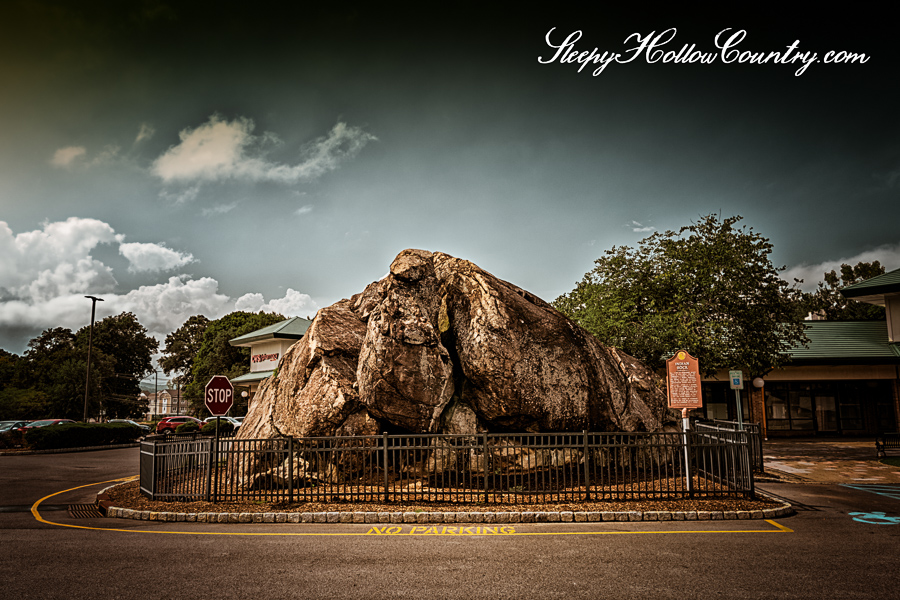
According to the historical marker, this behemoth of a rock is known locally as “Indian Rock” and is named as it was a meeting place for Native Americans before European settlers arrived on these shores. On the science side, this particular boulder is “17,300-ton Proterozoic granite gneiss and is .8 to 1.2 billion years old originating between the Ramapo Mountains and the Hudson Highlands.” Known as a glacial erratic, these types of ancient rocks were moved around by ice sheets 21,000 years ago. Rockefeller State Park Preserve has one of these as well.
For a time, the Indian Rock was part of a country estate owned by Otis H. Cutler, a businessman, politician, Freemason, Knight Templar, manager at the American Red Cross, and Rockland County native. He named the locale “Boulder Farm”.
In the historic year of 1996, the rock was preserved and incorporated into the design of the shopping area, which is named the Indian Rock Shopping Center. Very gneiss!


